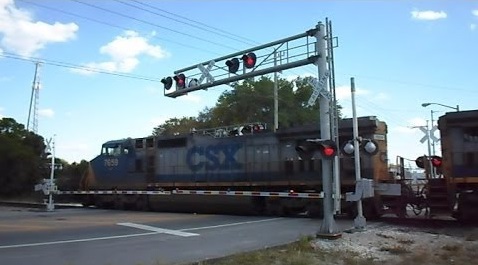As drivers, we don’t think about railroad crossings when we are driving our daily routine. Rarely do we see a train, but when we do we should use more precaution. Per the National Safety Council, a driver is 20 times more likely to be killed with a collision with a train, than with another vehicle. In the United States, a person is hit by a train on average once every three hours. That is a lot more accidents than what you would think. These types of accidents can result in serious injury or death. Many of these accidents could have been prevented if we all took more precaution.

Why are these statistics so high? There are a few reasons that can be given, but it all comes to the fact that we don’t have the respect that trains deserve. Only in Hollywood movies can a car race and beat the train through the crossing intersection, or a group of kids can outrun an oncoming train across a bridge. In reality, trains are usually the victors in these scenarios.
On average, a freight train with 100 cars can weigh anywhere from 12 million to 20 million pounds. If it is traveling at a minimum of 55 MPH, it would still take over a mile to stop with emergency braking, not to mention the potential to have its freight shift its weight and cause a derailment. The average family car weighs about 3,000 pounds. The weight ratio between a family car and a freight train is roughly 4,000 to 1. Imagine when a force of 12 million pounds hits a car – the car will be destroyed. Another way to think of it would be if a car were to drive over a full can of soda.
Many people don’t realize that freight trains do not run on set schedules and can be anywhere at any time going in any direction. Trains can travel at speed well over 70 MPH. That’s why it is a good policy to always expect a train at all crossings. Unlike another vehicle, locomotive engineers can’t swerve out of the way to avoid an object on the tracks. They can sound a warning horn and apply emergency brakes, but these measures won’t be enough to avoid hitting that object.
Below are a few helpful tips when at railroad crossings.
- Always expect a train at every highway – rail intersection. Trains don’t have fixed schedules. They can be on any track, at any time, and traveling in any direction. Reduce your speed when approaching a railroad crossing and look both ways before crossing when no warning lights are flashing.
- Stop for red flashing lights and crossing gates that are lowered. Drivers should also be aware of vehicles that are required to come to a complete stop before crossing any railroad tracks regardless of whether a train is approaching, such as school buses and vehicles carrying hazardous materials. Turn down the stereo in your car to listen for a coming train.
- Never drive around lowered gates. It is illegal and can be deadly. There is no reason to risk your life for a few extra minutes. This is where most of the train versus vehicle accidents occur. If you suspect a signal is malfunctioning, call the emergency number posted on or near the crossing signal or your local law enforcement agency. Today’s trains are faster, closer, and quieter than you think.
- Never race a train to the crossing. You will lose.
- Allow plenty of space between your car and the railroad tracks. Trains are very large vehicles that will overhang the tracks by several feet (17 feet high and 10 feet wide). The railroad stopping slashes on the roadway are a minimum of 15 feet from the rail.
- Do not drive into the train. This usually happens when the driver fails to stop either due to weather conditions, vehicle malfunction, or driver error.
- Only cross train tracks at the designated roadway crossings, look both ways, make sure all rails are clear, and cross the tracks quickly, without stopping. Make sure your vehicle will be at least 3 feet past the rails if your vehicle needs to stop for traffic on the other side. If not, then do not proceed.
- If your vehicle ever stalls on the tracks, get yourself and any passengers out of the vehicle and get away from the tracks, even if you do not see a train. Don’t try to take any other items with you. Locate the Emergency Notification System sign and call the number provided or the local law enforcement agency (911) and let them know about the stalled vehicle. If a train is approaching, run toward the train but away from the tracks at a 45-degree angle to avoid being injured by flying debris. When a train strikes a vehicle, it will send flying metal and glass ahead of and outward from the locomotive.
For more information on Operation Lifesaver, check out NVRPOLICE’s YouTube Channel for a video titled, “Operation Livesafer: It’s Your Call.”
